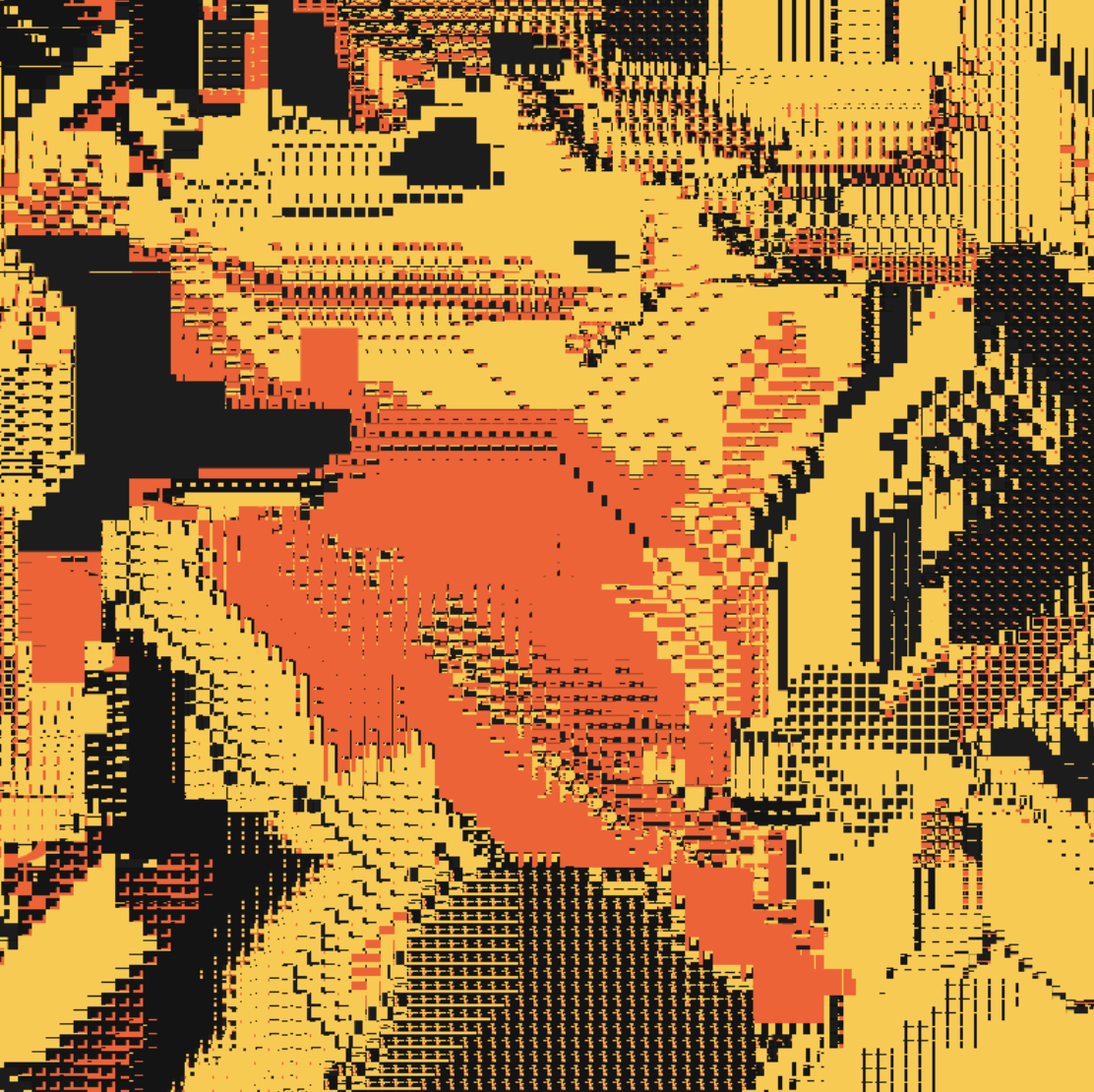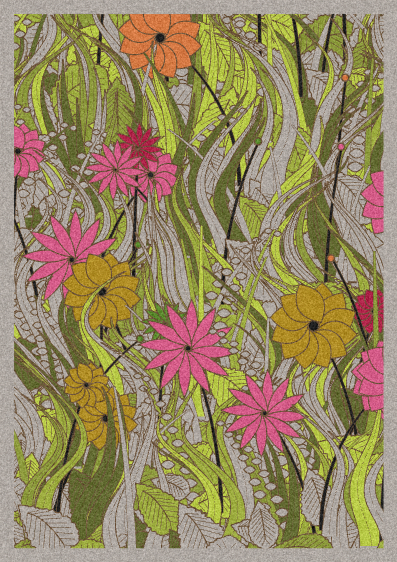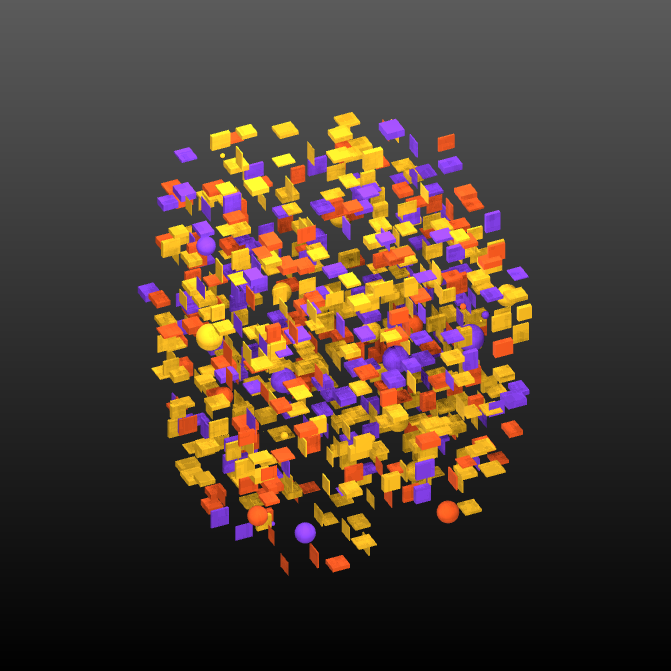Augmented reality (AR) overlays digital content onto the real world, typically through smartphones or AR-enabled devices. It entered mainstream awareness with apps such as Pokémon Go.
In art, and through apps like Artivive, AR offers a similar kind of magic—transforming static works into immersive, interactive experiences. Artists use it to reveal hidden layers, animate visuals, and invite deeper engagement, meet three Gamma Partner Artists who use AR in their practice.
Nate Hill is an artist who has long explored the intersection of digital and physical art, and in recent years, he’s added augmented reality (AR) to his creative toolkit. His foray into AR was driven by a curiosity about where technology might take his work. “I enjoy seeing where technology can take my art,” Hill says. “It gives a physical piece a bit of a wow factor too.”
For Hill, AR doesn’t just add flair—it expands the very nature of his artistic expression. As someone who creates both digital works and physical prints, he sees AR as a powerful way to merge those two realms. “As a digital artist that also produces physical prints,” he explains, “it combines those worlds in a really wonderful way.”
While some may see AR as an add-on to traditional art forms, Hill views it differently. “I think it’s an innovative medium,” he says. “Taking something that would normally be static and giving it life. It’s not something that you see much even now with the technology readily available.” This ability to breathe movement and presence into otherwise still artworks is part of what makes AR such a natural fit for his practice.
“It’s the perfect combination of the digital and physical,” he adds. “I’ve been creating in both worlds for a long time, so it’s brilliant to be able to bring them together.” AR offers unique opportunities that Hill finds particularly exciting—chief among them, its relative novelty. “It’s a use of technology that you don’t see a lot at this stage,” he says. “It brings something unique to how I can present my digital art.”
Of course, integrating AR isn’t without its challenges. “Creating the 3D or animated work that is engaging and enhances the final piece” is no small feat, Hill admits. But for him, the key to overcoming these hurdles lies in experimentation and creativity. “It’s all about experimenting and being creative.”
Audience interaction is another area where AR transforms the artistic experience. Hill is drawn to the immersive potential it offers. “There is definitely a wow factor in presenting art in this way,” he notes. “I definitely aspire to create an immersive artwork that draws people in—including movement and sound design.”
Though interactivity is not a major component of his current AR projects, it’s an area he’s keen to explore more deeply. “I use it sparingly at this stage,” he says. “Definitely something I’d like to use more.”
On the technological front, Hill acknowledges some limitations. “Ideally I would like to have my own app to trigger the AR activation,” he says. Looking ahead, he envisions AR becoming a more common tool among 3D artists and animators over the next five to ten years.
For traditional artists curious about incorporating AR, Hill has simple but encouraging advice: “It can become just another tool for your toolkit. Worth exploring.”
Finally, when asked about the contrast between the permanence of artwork on Bitcoin and the ephemeral nature of the AR layer, Hill reflects thoughtfully. “I think that most artists would like to leave behind a legacy of some sort—a lasting impression that your work was of some consequence,” he says. “And as technology evolves, I believe it’s important to evolve with it.”
In his work, Nate Hill exemplifies that very evolution—bridging the digital and physical, static and dynamic, ephemeral and permanent—all through the lens of augmented reality.

For Eka Lestienne, art has never been confined to what the eye can see. Her work exists across multiple dimensions—imbued with emotion, energy, and symbolism—often layered in ways both visible and hidden. It’s this layered depth that inspired her to begin working with augmented reality (AR), a technology that allows those unseen aspects to come alive. “AR offers viewers a more intimate and personalized journey through the artwork,” Eka explains. “It enables them to interact with the unseen, feel the subtle energies, and unlock messages that resonate uniquely with their own perception and experience.”
This capacity to invite exploration rather than passive observation is what sets AR apart from traditional formats in Eka’s eyes. “While traditional art invites contemplation, AR allows for interaction, immersion, and transformation,” she says. “It becomes a portal—unveiling hidden layers, activating energy fields, and guiding the viewer into a more personal and intuitive connection with the piece. It turns observation into exploration.”
Eka sees AR as both an extension of traditional forms and a revolutionary medium in its own right. “It builds upon the foundation of traditional art by preserving the emotional depth, symbolism, and aesthetic intention, while simultaneously breaking the boundaries of space, time, and perception,” she reflects. “It transforms the viewer from a passive observer into an active participant. In that sense, AR is not just a tool—it’s a new language of expression.”
Her art—rooted in intuition, symbolism, and multidimensionality—finds a natural partner in augmented reality. “It allows those hidden layers to emerge and be experienced in motion, in depth, and in personal timing,” she says. “With AR, each viewer can connect with the piece in a unique and immersive way, revealing different aspects as they explore—just like peeling back layers of a dream or a memory.”
For Eka, the medium offers unique opportunities that other formats cannot. “AR offers the rare ability to create living, evolving experiences where the artwork responds to the viewer’s presence,” she notes. “It blurs the line between the visible and the invisible, the material and the mystical. It turns stillness into movement, silence into vibration, and makes the unseen—felt.”
Yet, working with AR is not without its obstacles. “The main challenge is that AR is still an emerging technology, and the tools available are limited,” Eka explains. “I’m really waiting for more immersive and accessible solutions—like simple, everyday glasses that support AR experiences.” Although she’s had the opportunity to work with AR glasses in the past, such setups require technical teams and remain inaccessible to most audiences. For now, she uses tools like Artivive, which allows her to bring her artwork to life via mobile screens, though it does require viewers to install an app—a small but notable barrier.
To overcome these limitations, Eka turns to creativity and storytelling. “I create plenty of AR videos myself and actively bring my art into the world by visiting different places with my prints—famous museums, palaces, parks, monuments—and filming them in AR,” she says. These videos help make the experience more tangible for people, offering a glimpse into the magic of AR without requiring them to engage directly with the technology. “Through these immersive videos, I build curiosity and connection, turning limitations into opportunities for storytelling and wonder.”
The impact of AR on audience engagement is central to Eka’s vision. “It transforms the audience from passive observers into active participants,” she explains. “It invites them to go beyond the surface, to feel the energy, to discover hidden messages, and to experience the artwork unfolding in real time.” She aspires to create encounters that are meaningful, mystical, and deeply personal—experiences that linger long after they’ve ended. “I want them to feel wonder, curiosity, and connection—as if the piece is speaking directly to them.”
Though most of her AR projects focus on guiding viewers through layered discoveries, Eka has experimented with interactivity, too. “I once built an experience where the viewer could actually manipulate the layers themselves, which added a beautiful sense of agency and intimacy,” she shares. Looking ahead, she dreams of building entire multiverses behind each artwork—“living, breathing worlds that the viewer can enter, explore, and co-create with. AR is the first door to those new realities.”
But for this vision to flourish, technology must evolve. Current limitations—such as dependence on mobile apps and the limited interactivity offered by platforms like Artivive—pose real challenges. Eka is hopeful for a future where AR is widely accessible and no longer tied to flat screens. “I hope to see lightweight, affordable AR glasses become mainstream, with intuitive tools that allow artists like me to build rich, multilayered, interactive worlds without needing a technical team.”
In the next five to ten years, she envisions AR becoming an immersive, intuitive, and emotionally rich medium—integrated seamlessly into everyday life. “Artists will use it to craft entire universes, tell stories across time and space, and offer deeply personal, co-created encounters that blur the line between art, consciousness, and reality itself.”
For traditional artists curious about exploring AR, Eka encourages a playful mindset. “Start with curiosity, not perfection,” she advises. “You don’t need to be a tech expert to explore AR—just a storyteller with a desire to expand your canvas.” For her, AR is a tool for unlocking new layers of meaning and emotional depth. “Let your intuition guide you—what do you want people to feel or discover beyond the visible? That’s the magic AR can unlock.”
This interplay between permanence and ephemerality is central to Eka’s creative philosophy—especially when it comes to inscribing artwork on Bitcoin. “Each inscription is a portal, and the AR explains this perfectly,” she says. “The Bitcoin layer is eternal, immutable, like a digital fossil carved into time. It holds the core essence of the artwork. In contrast, the AR layer is alive, shifting, ephemeral.”
She sees this contrast as a poetic duality—“One is the anchor; the other is the wave. Together, they reflect the duality of creation—what is fixed and what flows.” In Eka’s world, art is always more than it seems. It lives in layers, moves between worlds, and invites us to step into realms just beyond the visible—realms that, with the help of augmented reality, we can finally begin to see.

For Superama, a visual artist captivated by the fusion of art and technology, augmented reality felt like a natural next step. “As a visual artist fascinated by the intersection of art and technology,” she explains, “I was drawn to augmented reality as a way to expand storytelling beyond the canvas. AR allows my work to come alive, inviting the viewer to feel and interact with the piece in a magical, unexpected way.” What began as curiosity soon evolved into a powerful extension of her creative voice—blending imagination, movement, and meaning into dynamic new forms.
Unlike traditional static artworks, Superama’s AR-enhanced pieces unfold as immersive experiences. “It transforms static visuals into immersive experiences, allowing my audience to step into the narrative,” she says. With AR, she’s able to expand stories, evoke surprise, and foster deeper emotional connections—turning observation into active exploration.
She sees AR as both a continuation and a transformation of traditional art forms. “It builds on the foundation of traditional art but transforms it into something interactive and alive,” she notes. “It’s not just a tool, it’s a living canvas that can evolve, transform, and breathe new life into the artwork again and again.”
This living, breathing nature of AR aligns perfectly with the essence of Superama’s practice. “My art is meant to move emotionally, visually, and energetically,” she explains. “Static forms can capture a moment, but AR lets me stretch that moment into an experience.” It’s a medium that allows her to bring her vibrant colors, conceptual depth, and feminine figures into a dimension where they can evolve and connect with viewers on new levels.
What makes AR uniquely powerful, she says, is its ability to turn imagination into immersive reality. “It’s like unlocking a hidden world within each piece, where the story unfolds through every interaction,” Superama explains. “That sense of wonder, surprise, and connection is something no other medium has given me.”
But the magic of AR comes with its own set of challenges. “The biggest challenge is guiding the viewer through the experience, making sure the technology feels intuitive and doesn’t create friction,” she admits. There’s also a learning curve on the artist’s side—new tools, formats, platforms, and the ever-present issue of technical limitations across devices.
To overcome these hurdles, Superama has developed thoughtful strategies. She prioritizes clarity and accessibility, using visual cues, QR codes, and clear instructions to ease the viewer into the experience. “Sharing my previous AR work on social media helps set expectations,” she adds, “so when I release something new, my audience already knows it comes to life through AR.” Staying curious and adaptable keeps her creative process fluid and open to innovation. “My goal is always to make the magic feel effortless.”
This attention to experience is deeply reflected in how her audience engages with her art. “AR transforms the viewer from a passive observer into an active participant,” she says. “It invites them to move, explore, and discover hidden layers within the artwork.” Her aspiration is to create moments of wonder, surprise, and emotional resonance—moments that feel personal and unforgettable. “Through AR, I want people to feel part of the story, to see themselves reflected in the experience, and to walk away feeling inspired.”
Interactivity is not an afterthought in her work—it’s the heart of it. “It’s what transforms the artwork into an experience,” she explains. Every project is designed with the viewer in mind, considering how they might react and connect emotionally. One of her most rewarding moments, she shares, is seeing a viewer’s face light up with surprise and joy: “It reminds me why I create these experiences.”
Still, the technology isn’t without its limitations. “Many AR experiences still require downloading an app, which creates friction for the viewer,” she notes. Her hope is for a future where AR becomes seamless—where any phone can activate an experience instantly, without barriers. “I know we’re getting closer,” she adds, “and I’m excited for the moment when AR becomes as effortless as taking a photo.”
Looking ahead, Superama envisions AR becoming a standard part of how we experience art—fully integrated into galleries, public spaces, and our everyday devices. “Digital art with AR will become the norm, and any device will instantly recognize and activate the experience,” she predicts. “You’ll explore, connect, and even buy artwork with just a gesture.”
To traditional artists curious about this evolving medium, her advice is simple: “Explore AR with curiosity.” She sees it as a way not only to add movement and narrative to artwork but also to make it easier for collectors to connect and engage. “Find a way that feels true to your style,” she encourages, “and let it take your artwork to the next level.”
For Superama, AR is also a bridge between permanence and ephemerality—a tension she explores through her use of Bitcoin inscriptions. “The permanence of Bitcoin inscriptions gives my work a sense of legacy… it’s archived forever,” she says. “In contrast, AR allows me to play, update, and evolve the experience over time.” One layer is eternal, while the other is alive only through interaction. “Together, they reflect the duality I often explore: the physical and the digital and the timeless question we all ask ourselves: do I want to live forever?”





